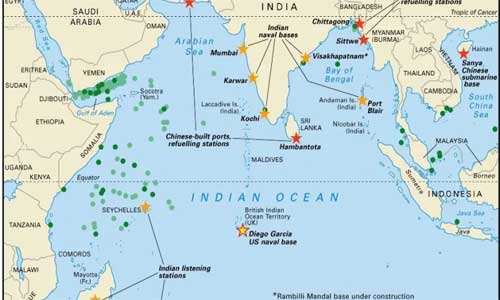Indian Ocean region is considered significant for the major powers in the international political arena. These powers see their security, economic and political interests connected to the region tightly; particularly, because of the large resources, dense population and consumer markets. Their initiatives and policies towards the region determine the course of the international relations, also those of the region. Therefore, it is necessary to see how these powers design their strategies towards the region and what initiatives they take to pursue their interests, and what can be the possible consequences of these strategies on the region as a whole.
THE UNITED STATES
The strategy of the United States in Indian Ocean is security-oriented, which pursues more military strength in the region. The strategy can be comprehended through what Trump administration termed Indo-Pacific Strategy, also Free and Open Indo-Pacific Strategy, which considers the Indian Ocean and Pacific region together. Though given a new name, this strategy is not much different from the strategy that was adopted by the Obama administration – the Asia-Pacific Rebalance. The projects and initiatives that were the part of Obama strategy are also the main components of Indo-Pacific Strategy, except that in the later, the US withdrew from the Tans-Pacific Partnership Agreement.
A significant aspect of this strategy, keeping in consideration the Indian Ocean region, is its motivation for a larger role of India in the region. In fact, this aspect is linked to the George W. Bush’s idea of Quad – a coalition of Australia, Japan, US and India. The basic aim of such a priority is to exert influence in the region and also to counter the growing influence of China. As a matter of fact, the US has been looking at India for a balance of power strategy in South Asia and the Indian Ocean region.
However, to understand the overall strategy of the US in the region, it is vital to see it in connection to their South Asian policy, that sees to exert pressure on Pakistan for the war against terrorism and also to seek solution for the Afghan issue. The policy sees better economic and military relations with India and a stricter role against Pakistan – one of the reasons being the development of China-Pakistan Economic Corridor (CPEC). Through CPEC, China’s vision of Belt and Road Initiative (BRI) is being realized, which can further strengthen China’s economic relations with Gulf and African countries. It also puts Pakistan in an important position, and makes it a key state in China’s realization of BRI.
As far as US policies towards Gulf and African countries are concerned, they are highly military-based. The US has established many military bases at Diego Garcia and in the Persian Gulf. Some of its bases are also located at Djibouti, in the Horn of Africa, and in Ethiopia. These bases can house around 5,000 personnel at a time, and can be moved quickly for military maneuvers in the region. The military bases at Persian Gulf are mostly directed towards Iran because of its sour relations with the country. Moreover, the same can be used against Russia and China that seem to be making their military presence felt in the region. These military bases have also supported the Gulf countries, especially Saudi Arabia and UAE to strengthen their military capabilities against Iran.
Thus, the role of the US in the Indian Ocean region can be considered to be security-oriented, mostly to create a balance of power against China, Russia and Iran.
CHINA
China sees the Indian Ocean region vital for its grand strategy and significant economic interests. The Indian Ocean region is indispensable for its Maritime Silk Road initiative which is a sea-based part of the greater BRI. China’s Indian Ocean policy includes all the areas around the ocean, stretching from East Asia to Persian Gulf and then to the African continent. An important part of this initiative is CPEC, which is the trade corridor from western China, through Pakistan and reaching Indian Ocean through Gwadar Port. The initiative is a multi-billion-dollar program, including development and infrastructure projects, with the aim to facilitate economical and speedy Chinese trade to the Middle East and the African countries.
China has been establishing important trade links with the Gulf countries and Iran as well.
China’s technology business has huge markets in Gulf countries. However, China has made sure that its relations with countries like Saudi Arabia do not influence the relations with Iran. Moreover, China has reached to African countries as well, and it is the most favored trading partner of the countries in Africa. Recently, China has established military base in Djibouti – the only military initiative by China in recent years. Moreover, it has participated in military exercises in Indian Ocean with Russia. However, China has always placed more importance to economic priorities in the Indian Ocean region.
In the light of above information, it is not difficult to see an intense power struggle in the Indian Ocean region between the two great powers of the world – US and China. However, it is vital that this competition must not turn into military adventurism. Competition in the economic sphere can help the the countries like Afghanistan, Pakistan, India and Iran to benefit to a large extent; however, untamed power politics based on military dominance can only lead to further misery for the South Asian, Central Asian, Middle Eastern and the Southeast Asian regions.
Home » Opinion » Power Politics in the Indian Ocean
Power Politics in the Indian Ocean
| Sajjad Aasim

